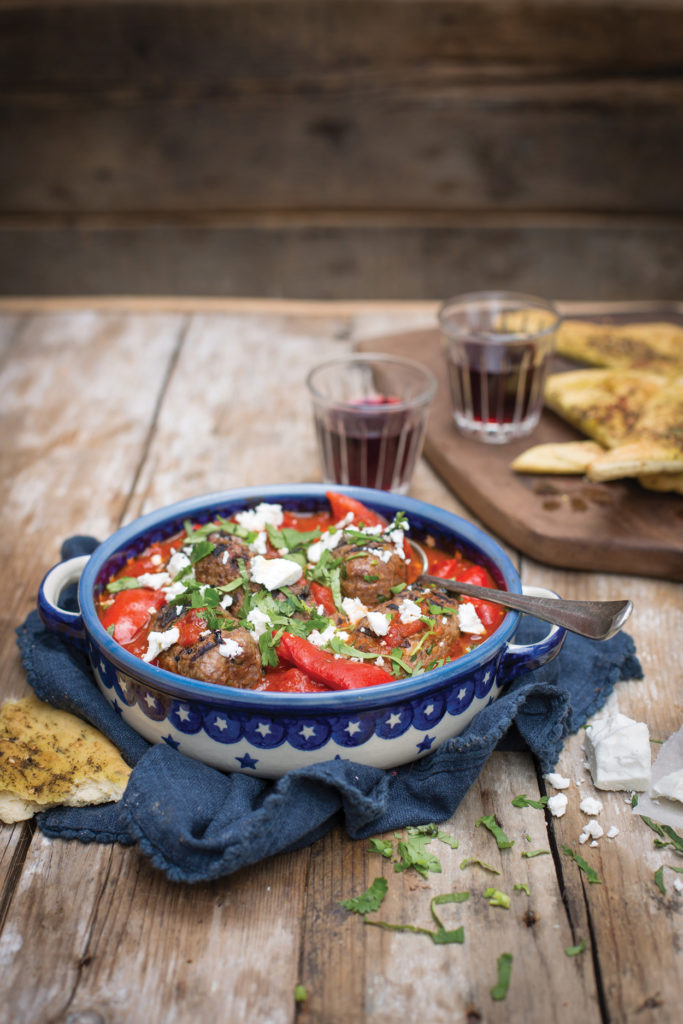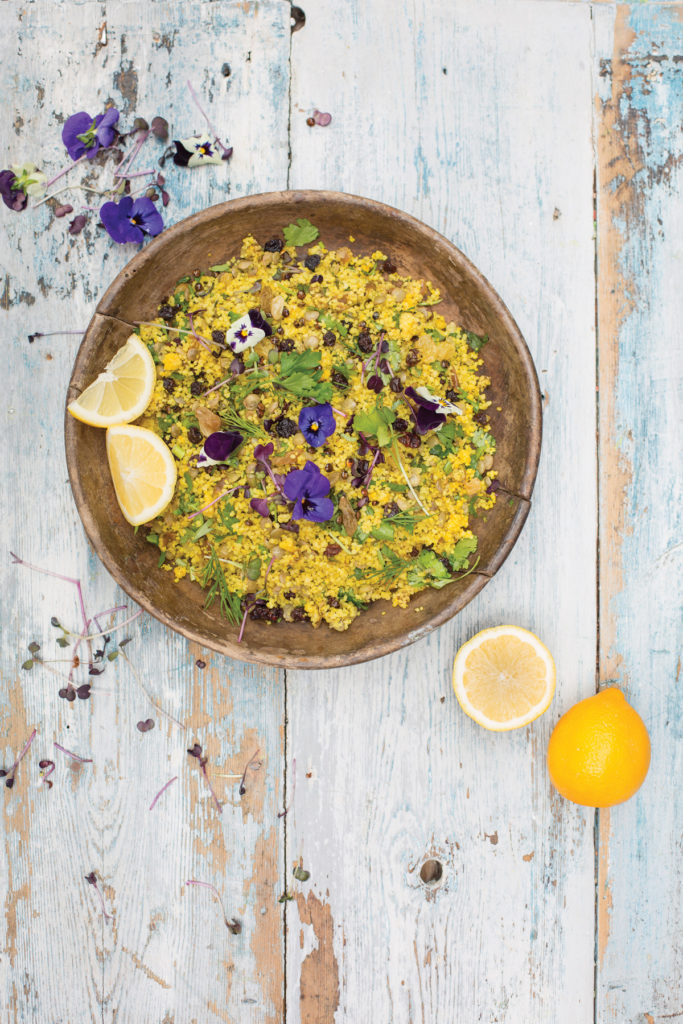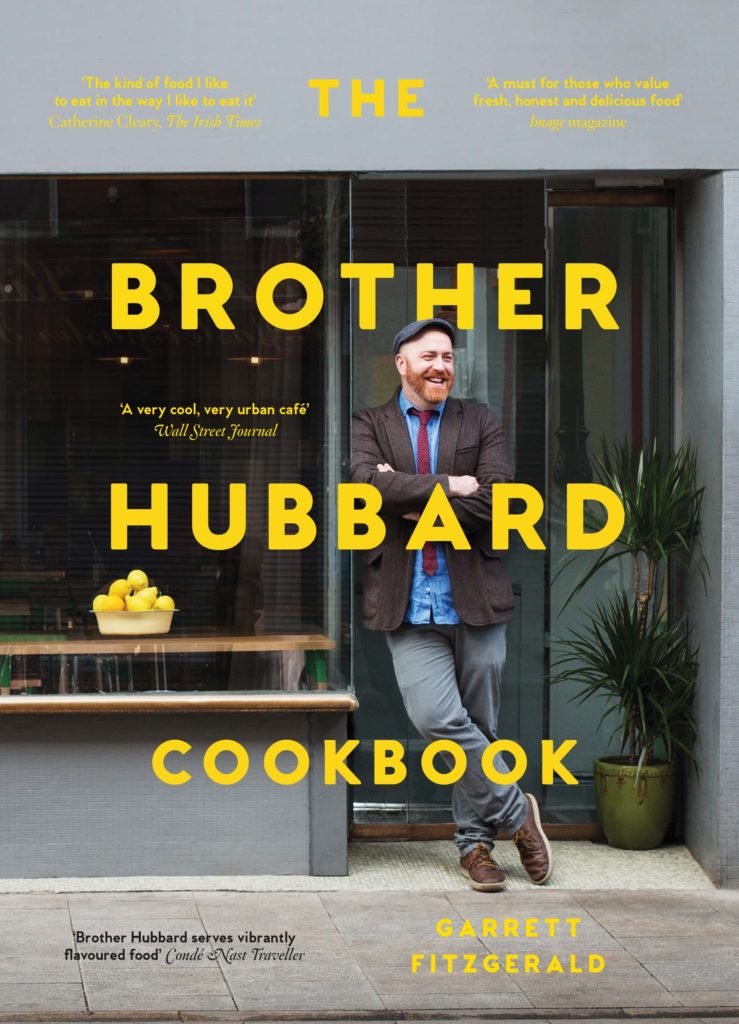
To celebrate their new cookbook, Brother Hubbard have shared one of their evening recipes and their suggested side to pair with it for you to make at home yourselves. Extracted from the book below, find both Brother Hubbard recipes, for the perfect Middle-Eastern style dinner.
Brother Hubbard’s Beef Koftas
Oh my! This is one very special dish. The kind of dish you will be thinking about long after you’ve had it, plotting when to have it next. Koftas are simply a Middle Eastern version of meatballs. As with a lot of our dishes, these are full of herbs and flavour – please don’t be shy with the fresh herbs, as they make such a meaningful difference. The sauce packs a welcome punch to make these a wonderful lunch, dinner or supper.
This recipe bulks up incredibly well if cooking for a larger group. It will take a bit more effort to hand-roll more koftas, but honestly, it’s worth it. In fact, this is one of my go-to recipes for entertaining at larger gatherings.
We recommend serving these with the wedding couscous. Any leftovers make an amazing sandwich with some baby spinach leaves in a warm pitta with a little of the sauce. Both of these Brother Hubbard recipes serve four.
You'll need:
750g lean minced beef (rib mince is good)
150g feta cheese, crumbled
50g fresh parsley, chopped
50g fresh mint, chopped
5 garlic cloves, finely minced or crushed (2 tbsp)
2 tsp dried mint
2 tsp ground cumin
1 tsp ground cinnamon
1 tsp allspice
For the tomato and roast red pepper sauce:
olive oil
2 red peppers, diced into 1cm cubes
1 medium red onion, finely chopped
4 garlic cloves, thinly sliced or chopped
50ml apple cider vinegar
2 tsp ground star anise or fennel seeds
2 x 400g tins of chopped tomatoes
150ml water
2 tbsp tomato purée
pinch of caster sugar
salt and freshly ground black pepper
Method:
1. To make your sauce, heat a little oil in a medium-sized pot. Sweat the red peppers, red onion and garlic together, covered, until softened – 10–15 minutes on a low-medium heat should do it. You want them to be well softened without falling apart too much. Next add the cider vinegar and the ground star anise or fennel seeds (if you can’t get ground star anise, use two whole ones) and simmer for about 15 minutes, keeping an eye on it to make sure the dish doesn’t dry out.
2. Add the chopped tomatoes, water, tomato purée, sugar and seasoning. Reduce to a quite thick sauce, like pasta sauce, stirring regularly to prevent it from sticking. When the sauce has reached your desired consistency, remove from the heat and taste, adjusting the sauce with sugar, vinegar or seasoning as you see fit – you want a really fragrant sauce that’s full of flavour. If you’ve used whole star anise, take them out at this stage. Put to one side.
3. Preheat the oven to 180°C. To make the koftas, put all the kofta ingredients in a large bowl, reserving a quarter of the feta and a quarter of each of the fresh herbs to use later (don’t add salt, as the feta will bring saltiness to it all). Mix well with your hands until everything comes together as one, but don’t overmix or it will turn into a fine paste!
4. When well combined, test the mix by frying a little bit in a pan with a little oil. Leave to cool for a moment and taste. This step is critical: decide if you need to add more pepper, garlic or spices if you feel it’s needed. You can also add a little salt if you feel it’s necessary. Adjust and repeat the tasting step if necessary until it’s just right.
5. Using a kitchen scale, weigh out small 50g balls of the mixture – or just do one like this to get an approximate idea of how much you need, then shape the others to that size (about the size of a walnut in its shell). Form the balls into slightly oval shapes and place on a baking tray. If you’re not cooking these right away, they can be covered with cling film and refrigerated for cooking later.
6. To cook the koftas, we char them on a preheated griddle pan (at maximum heat) for 1–2 minutes on each side, making sure they are well browned on a few sides. A frying pan would be fine here, though you won’t get the char marks. This step sears the meat and adds additional flavour from caramelising (browning) the outside of the kofta, but see the tips and tricks for advice if you want to skip this step.
7. Transfer to a baking dish and pour the warm sauce over. Place in the oven and cook for 20 minutes. If you have a thermometer probe, they should hit 71°C – if you’ve minced the meat yourself and are confident as to the quality, you may prefer them to be a little rarer. Bring the koftas to the table in the baking dish, with the remaining feta and herbs sprinkled over, for serving alongside any accompaniments (the wedding couscous, flatbread and perhaps some salad). Otherwise, plate up the individual portions, sprinkle with the feta and herbs and serve with the accompaniments.
Garrett's tips and tricks:
This sauce will hold perfectly, so make multiple batches at once andfreeze to make it so much easier to do this recipe the next time.
The koftas work very well as part of a mezze selection and are as good warm as they are piping hot. If anything, all food tastes better warm rather than piping hot.
A spoonful of thick Greek yogurt drizzled over the koftas and sauce when serving works wonders here, but better still would be our smoked aubergine yogurt (page 338 – it is rather mind-blowing) and maybe even a drizzle of our homemade hot sauce (page 330).
You could make this recipe with mixed lamb instead, in which case I recommend doubling the amount of dried mint.
Skipping the charring: If you’re cooking for a lot of people, skipping this step won’t have a devastating outcome! Instead, preheat your oven to 230°C and pop the koftas in a large baking dish greased with a little oil and cook in the oven for 6 minutes, giving them a shake halfway through. Take them out of the oven and drain off the juices and oil, then add the heated sauce, turn down your oven to 180°C and pop them back in for 15–20 minutes, testing as suggested in the main recipe above.
Pair with: Brother Hubbard's Wedding Cous Cous

Inspired by a recipe from Greg Malouf, a wonderful Australian chef, this is a really delicious way to eat couscous, which is too often considered to be a bland carb. We’ve taken inspiration from his recipe but added some extra elements with the caramelised onions and the lentils, which elevate the couscous to a far more substantial experience.
You'll need:
100g green or brown lentils
300g couscous
2 tsp ground turmeric
salt and freshly ground black pepper
extra virgin olive oil
350ml boiling water
100g caramelised onions (page 346)
50g fresh herbs, chopped
30g dried fruit (currants, sultanas, cranberries)
30g almonds, toasted and chopped (see page 352)
zest and juice of ½ lemon or orange
20–30g edible flowers (such as marigolds or nasturtiums), to garnish (optional, but worth it!)
Method:
1. Pop the lentils into a pot and cover with at least 3cm of water. Bring to a simmer and cook for 15–20 minutes, until they are soft but still holding their shape. Drain well.
2. Place the couscous in a large shallow container. Add the turmeric, seasoning and a good drizzle of olive oil. Mix well, ensuring all the couscous is well seasoned and covered in the oil. Pour over the boiling water and give it a good mix with a large spoon. Cover the couscous with cling film and leave to rest for 10 minutes or so, giving it a good stir midway through with a fork so it breaks up nicely rather than forming clumps. When it’s done, use your fingers or a fork to fluff up the couscous again and to make sure all the water has been absorbed.
3. At this point, add all the other ingredients to the couscous. Place in a large serving bowl and drizzle with the lemon juice. Taste and adjust the seasoning, then garnish with the edible flowers and serve.
Garrett's tips and tricks:
To make this more of a salad dish in its own right, add 100g cooked chickpeas and double the amount of herbs as well as perhaps increasing the lemon element by half again. Some finely diced celery would also give it a nice crunch. Or you could go so far as adding some roast carrot slices to bulk it up even further.
To make it a bit more interesting, stir 1–2 tablespoons of harissa (page 325) into the water before pouring that over the couscous.
Some pomegranate seeds scattered over it all would be a juicy and beautiful addition too.
The Brother Hubbard Cookbook

The Brother Hubbard Cookbook is in shops now, priced at €27.99. It's packed chock-full of Brother Hubbard recipes from both the original Capel Street Brother Hubbard cafe and Sister Sadie (soon to be Brother Hubbard South). Leaning towards aspects of Middle Eastern and Southern Mediterranean food, the cookbook is packed with nutritious, wholesome, often deceptively vegetarian dishes that emphasise flavour, colour and texture.
Cafe favourites like Turkish Eggs Menemen, the Brother Hubbard Croque Monsieur, Moroccan Harira Soup, Middle Eastern Slaw and Harissa Baked Aubergine with Saffron Yogurt, are all included in the book, which also gives a taste of the Brother Hubbard story. Written in a style that will inspire even the most reluctant cook to have fun and to create a dish of which they can be proud, this is food that demands to be shared, that will make you feel better – in both its preparation and its enjoyment.
For more information, visit the Brother Hubbard website.












